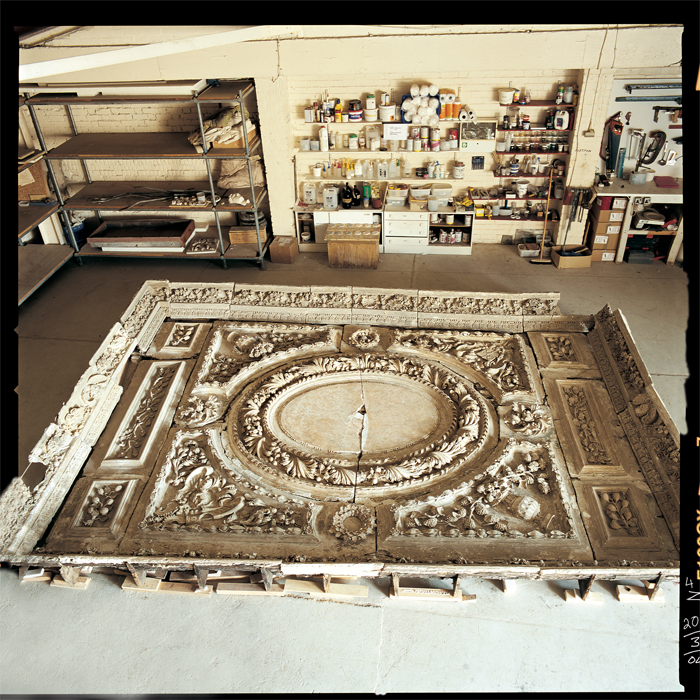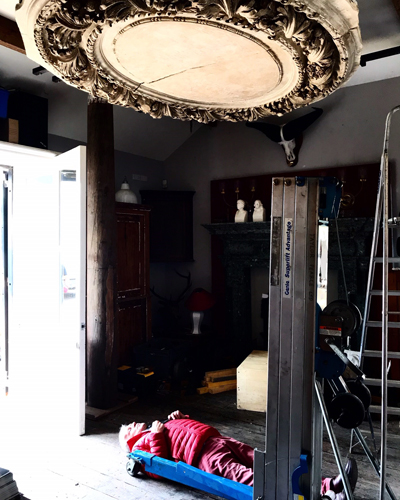A Glorious Revolution: The Wheelergate Ceiling
In 1998 “Salvo News”, the trade newspaper for the Architectural Salvage trade, ran a small piece detailing the plight of a very old chopped-up plaster ceiling – stacked in the stables of a house in Derbyshire. Peter Hone, these days LASSCO’s consultant Plaster Caster, who has never been able to resist any such opportunity, leapt into action. A race up the motorway in a clapped-out old van followed. He found several tons of extraordinary and lavish castings languishing in the stables of Holme Pierrepont Hall. The ceiling panels were covered in grime and pigeon guano. A deal was done and a somewhat over-loaded crawl back down the M1 ensued.
Twenty years later and the ceiling is now for sale at LASSCO Three Pigeons.

Removed from Holme Pierrepont during restorations there in the late 90’s, the ceiling – 350years old – was not however original to the early Tudor house. It had only been installed there for 15 years. It originally came from Nottingham.
The ceiling had been salvaged by the City Corporation Highways Department in 1961 when the venerable Merchant’s House at 4-6 Wheelergate in central Nottingham – the building which it adorned – was demolished. It was well-known in Nottingham; it had stood there for 280years. The building had been occupied by “The Oriental Café” for its last sixty years: a popular meeting spot with a very fancy ceiling.
The Nottingham Evening Post had made mention of the ceiling in The Oriental Cafe:
“… a very good specimen of 17th Century plasterwork in deep relief, a composition of fruit, scallops, foliage, and cherubs that frown down on the fountain-like movement of the orangeade dispenser…”.
They later detailed its removal as the house was demolished by the Highways Department:
“The floor above the ceiling was removed, timber beams put in above it, and sections of the ceiling cut out and lowered by block and tackle … the central oval … was lowered in one piece, but had to be cut in two later to get it out of the building”.
There was an outcry about the demolition – but for the ceiling to be saved was both commendable and unusual in 1961. It then lay in a Council depot for 20years before HolmePierrepont Hall acquired it in the mid-80’s.
***
When Peter Hone came off the M1, with several tons of plasterwork on board, and ground his way into London he lurched over to Peckham and enlisted the help of renowned restorer Keith Taylor in Peckham. Keith had the know-how and the patience to take the ceiling in. It has been with him since. During that time much painstaking restoration work has been undertaken in phases. Countless layers of paint have been removed to reveal the virtuoso plasterwork in wonderful detail.
Rupert Van der Werff, formerly of Sotheby’s, is quoted in World of Interiors, in May 2004:
“To find a ceiling of this quality is rare. For it not to be in situ is very, very rare.”
We suspect it may in fact be unique.
And if this ceiling could talk, the tales it would tell. There are some accounts of it in situ at 4-6 Wheelergate written in 1912 and later – recorded by Harry Gill, writing for the Thoroton Society . He and other contributors narrow the likely date to the construction of 4-6 Wheelergate to 1680 – part of a new wave of post-Restoration construction in the city.
J. Holland Walker, writing in the same journal in 1931, ventures that it was under the then new ceiling that an important historic meeting took place –
“In 1688 an event of the greatest importance occurred at the Malt Cross. Public feeling had been settling against James II and his policy and at last it had come to a head. The Duke of Devonshire was the great leader in this neighbourhood and after a conference with the leading gentry of the Midlands, which had taken place probably in what is now the Oriental Cafe in Wheeler Gate, the Duke, accompanied by Lord Delamere, Sir Scroop Howe, Mr. Hutchinson and others, proceeded to the Malt Cross where they read a declaration that they had decided to throw in their lot with William, Prince of Orange. The market folk gladly followed their lead and as far as the Midlands were concerned James’s cause was lost.”
If Holland Walker is correct, the ceiling, bore witness to a momentous historical event – a turning point in the Glorious Revolution of 1688. William Cavandish, 3rd Earl of Devonshire 1640-1707, was part of the “Immortal Seven” group that invited William III, Prince of Orange to depose James II of England as monarch during the – mostly bloodless – uprising (he was rewarded with the elevation to Duke of Devonshire in 1694). The Earl made Nottingham the Northern headquarters for the rebellion and the Wheelergate house, centrally located and over-looking the Malt Cross, would certainly have been a splendid place to have held court. The ceiling is a very early example of its type – adopting the radical Inigo Jones styles introduced at The Queens House, Greenwich [1620s] and Banqueting Hall, Whitehall [1622]; it would have been the talk of Nottingham – the like of which they’d never seen before.
And at LASSCO Three Pigeons we’ve just had our own Glorious Revolution – the central oval section has been flipped over and hoisted up. Half a ton of 17th Century plaster can now be viewed from below. Very old, spectacular and of historic significance we are thrilled to have it here for sale.
Come and view the Wheelergate ceiling at LASSCO Three Pigeons – the full catalogue entry, with measurements, price and a more of the story, can be found here.
And our large inventory of smaller plaster castings – from large plaques to small roundels – can be found here.

The latest Salon event at LASSCO Brunswick House in London expands further on plasterwork in tonight’s talk: Tickets are still available for tonight’s event (Wednesday 12th June 2019): Info here – Tickets here.
